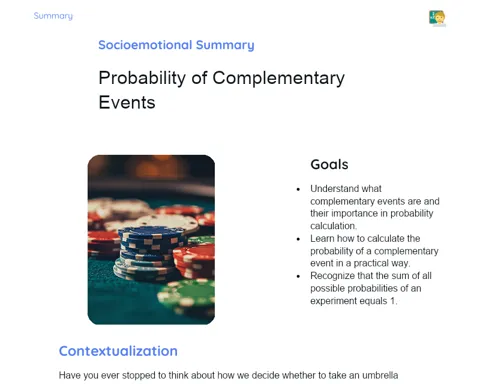Percentage: Discounts or Percentage Increases | Active Summary
Objectives
1. 🎯 Understand and apply the concept of percentage in practical situations involving discounts and percentage increases.
2. 🎯 Develop skills for calculating percentages and apply them in buying and selling contexts, such as in supermarkets and stores.
3. 🎯 Learn to use percentages to make more informed and effective economic decisions in daily life.
Contextualization
Did you know that the ability to calculate discounts and percentage increases is not only useful but often essential in our daily lives? From taking advantage of supermarket deals to understanding the impact of a salary increase, percentages are everywhere. In major shopping events like Black Friday, for example, quickly and accurately calculating discounts can make a huge difference in your wallet. This knowledge is not just mathematical; it is also a powerful tool for conscious consumption and personal financial management. Let's explore how mastering this concept can transform the way you make economic decisions!
Important Topics
Percentage Discount Calculation
Understanding how to calculate percentage discounts is crucial for saving money on daily purchases. This calculation is simple: just multiply the original price of the item by the discount percentage (expressed as a decimal) and subtract that value from the original price. For example, if a book costs R$ 50.00 and has a discount of 20%, the calculation would be: 50 * 0.20 = 10. Thus, the new price would be 50 - 10 = R$ 40.00.
-
Multiply the original price by the discount percentage (in decimal).
-
Subtract the discount value from the original price to get the new price.
-
This concept is fundamental for purchasing decisions and understanding promotions.
Percentage Increase Calculation
Just like discounts, percentage increases help us understand how the price of an item goes up. To calculate the final price after a percentage increase, multiply the original price by the increase percentage (in decimal) and add that value to the original price. For example, if a product costs R$ 80.00 and undergoes a 25% increase, the calculation would be: 80 * 0.25 = 20. Thus, the new price would be 80 + 20 = R$ 100.00.
-
Multiply the original price by the increase percentage (in decimal).
-
Add the increase value to the original price to get the new price.
-
This knowledge is useful for understanding price changes and planning expenses.
Application in Everyday Situations
Applying percentage discounts and increases in real situations, such as shopping in supermarkets or managing personal budgets, helps solidify the practical understanding of these mathematical concepts. Knowing how to quickly calculate how much will be spent after a discount or how much an increase represents in terms of savings is a valuable skill for everyone.
-
Use knowledge of percentages to compare prices of products with various discounts.
-
Apply percentage calculations to adjust budgets and plan expenses more efficiently.
-
These practices reinforce learning and highlight the importance of mathematics in everyday life.
Key Terms
-
Percentage: A measure that expresses a ratio as a fraction of 100. It is used to calculate discounts and increases in prices.
-
Percentage Discount: A reduction in the price of an item expressed as a percentage of the original price.
-
Percentage Increase: An increase in the price of an item expressed as a percentage of the original price.
To Reflect
-
How can the ability to calculate discounts and percentage increases impact your daily purchasing decisions?
-
In what ways can understanding percentages help manage your own money and family budget?
-
Think of a scenario where a salary increase is offered as a percentage increase. How could you calculate and understand the impact of that increase on your earnings?
Important Conclusions
-
Today, we explored how percentage is a powerful tool in our daily lives, especially when dealing with discounts and percentage increases in purchases and sales.
-
We learned how to calculate discounts and percentage increases, essential skills for saving money and making smarter financial choices.
-
We saw that mathematics is deeply integrated into our daily activities and that mastering these concepts not only helps in practical situations but also improves our ability to make informed decisions.
To Exercise Knowledge
- Discount Calculator: Choose 5 products from a supermarket and simulate discounts of 10%, 15%, 20%, 25%, and 30% for each item. Calculate the new price after the discount and record the values. 2. Shopping Diary: For a week, record all your purchases and calculate the total amount you would have spent if each purchased item had a 10% discount. Compare the total amount with what you actually spent. 3. Budget Simulation: Create a monthly budget for a teenager who receives an allowance and calculate the impact of a 15% increase in their income.
Challenge
🌟 Discount Master Challenge: Imagine you are the manager of a store and need to create a promotion to quickly sell 10 different products. Calculate discounts that attract customers and still ensure profit for the store. Present your strategy in a small explanatory text and a comparative chart of the original and final prices of the products.
Study Tips
-
Practice regularly: The more you practice with percentage problems, the faster and more efficiently you will be able to calculate discounts and increases.
-
Use technology: Percentage calculator apps can be very helpful for verifying your calculations and learning new problem-solving strategies.
-
Discuss with friends or family: Explain how you calculate discounts and increases to them. Teaching is a great way to reinforce what you've learned.



